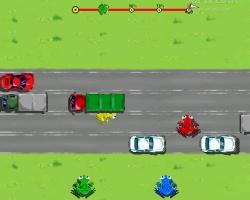Everyone who works with middle schoolers knows this unique and wonderful age is all about transition. Everything in their lives is being up-ended, remixed, re-sorted and super-sized. It’s nuts, really—a bit like playing real-life Frogger.
Do you remember the video game Frogger? Ah, back when the good games were two-dimensional. One simply moved the little frog off a curb and into the street, where he just had to cross while avoiding passing vehicles. On other levels of the game (ooh, complexity!), players moved the frog off a shore and onto lilly pads and passing turtles. In either mode, the goal was simple: Get to the other side!
Silly Boys
Not long ago, I had a reunion with my former middle school guys’ group. They are now all sophomores in high school. After sensing they were going to destroy my yard and terrify my neighbors, I prompted the gang to take a walk with me to a local Starbucks.
When we got to a major intersection where we had to wait for a traffic signal before crossing five lanes of traffic, one boy suggested, “Let’s play Frogger!”
I said, “Uh, what?” Apparently the other guys all knew what he meant, and merely thought I’d never heard of the game. (Oh, silly boys!) The boy started explaining this old-school video game called Frogger. “No, I know the video game,” I said, “but what do you mean we should play it here?”
“We run out into traffic and avoid the cars!” the boy said. His face was beaming, as if he’d just seen God’s back. He was serious, as were the other eager knuckleheads.
I know this is cliché to ask but, seriously, how does the human race survive adolescence?
Back to the Frogger Transition
This “leaving one shore, moving into the treacherous in-between, and arriving at a safe far shore” was the picture of early adolescent transition I worked with in my own mind and ministry for most of my middle school ministry years. It’s not wholly inaccurate and certainly makes sense—in a two-dimensional world. The problem was that it didn’t really match up with the three-dimensional kids I was encountering every day.
For example, why did one sixth grader—who is very close to my heart and clearly has “launched” into early adolescence—cry last night in his mother’s arms like a broken child over something seemingly insignificant? What about the girl—who looks and dresses (and struts) like she’s 16—still have almost no clue about her effect on boys? What about the guy in my small group who seems the most physically mature but thought that wet dreams were “peeing while you’re sleeping.” These are the situations for those who are “no longer children, but not yet high schoolers.” They aren’t two-dimmensional Frogger games.
This is where my understanding of early adolescent transition collapsed on itself like some kind of developmental dying star. The “ah-ha” hit me: It’s not a two-dimensional transition from “no longer that” to “almost there”; it’s an overlapping transition from “still that” to “already there.” In other words, middle schoolers are living the in-between space of still being a child and already being a teenager/young adult.
It is both/and, rather than either/or.
That, my middle school ministry friends, explains a lot! Let’s give them space, shall we, to still be children while dipping their toes (and usually a whole lot more) into the world of “not children”?




